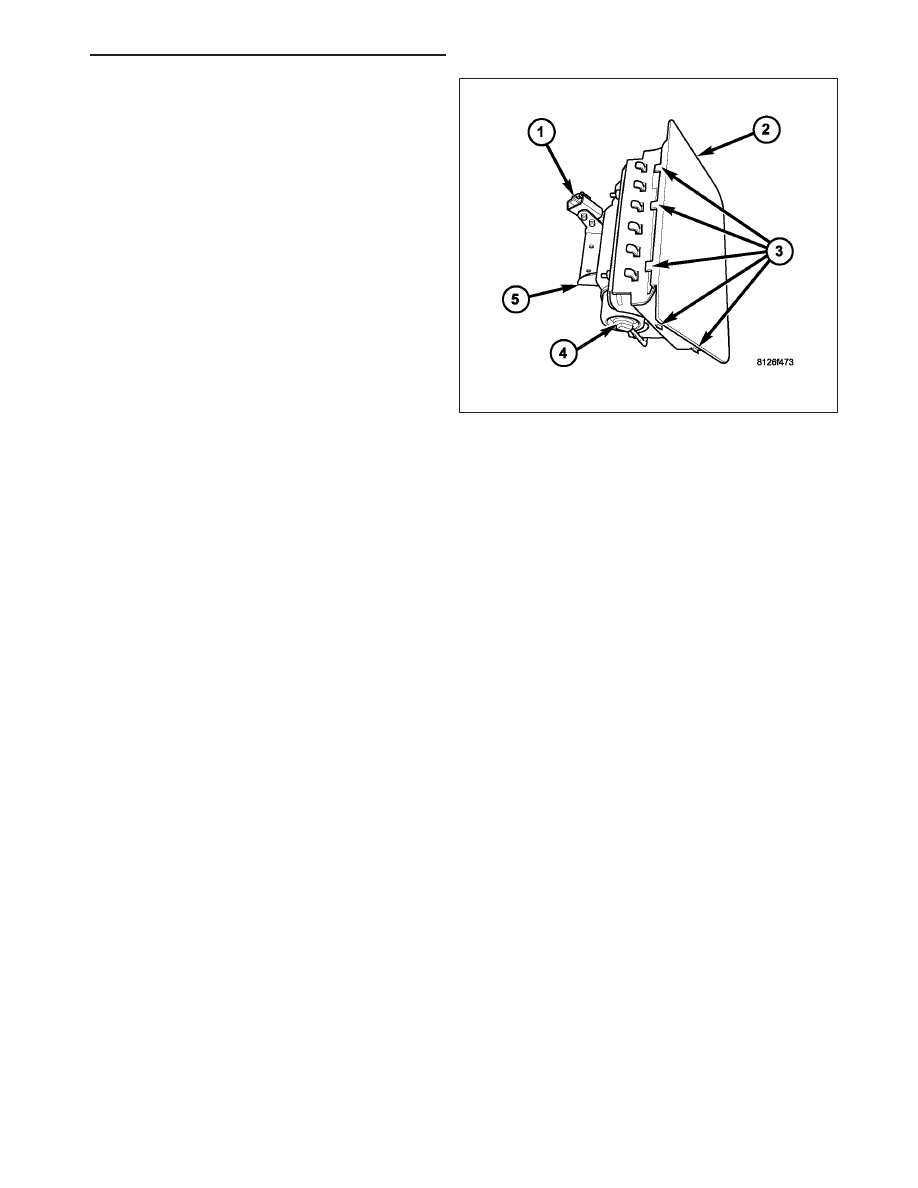Dodge Durango (HB). Manual - part 558

The outboard edges of the airbag door are secured
with integral snap features (3) to the instrument panel
base trim. Located below the passenger airbag door
(2) within the instrument panel is the passenger airbag
unit. The passenger airbag housing fits into a molded
receptacle on the back of the airbag door, where
twelve stamped hook formations on the forward and
rearward edges of the airbag housing are engaged in
mating small window openings on the forward and
rearward flanges of the receptacle to secure the air-
bag door to the airbag housing. These airbag door
fasteners and mounting provisions are all concealed
beneath the instrument panel base trim. The passen-
ger airbag unit is secured by two screws through a
stamped mounting bracket (5) to the instrument panel
structural support.
The passenger airbag unit used in this model is a multistage, Next Generation-type that complies with revised fed-
eral airbag standards to deploy with less force than those used in some prior models. The passenger airbag unit
consists of a stamped and welded metal housing, the airbag cushion, the airbag inflator, and a stamped metal air-
bag cushion retainer plate that is secured to the airbag housing with four studs and nuts. The airbag housing con-
tains the airbag inflator and the folded airbag cushion. An approximately 80 centimeter (31.5 inch) wide by 90
centimeter (35.5 inch) high rectangular fabric cushion is used.
The airbag inflator (4) is a non-azide, pyrotechnic-type unit that is secured to and sealed within the airbag housing.
A short four-wire pigtail harness with a keyed, yellow connector insulator (1) connects the two inflator initiators to the
vehicle electrical system through a dedicated take out and connector of the instrument panel wire harness.
The passenger airbag includes the airbag door. This unit cannot be repaired, and must be replaced if deployed,
faulty, or in any way damaged.
OPERATION
The multistage passenger airbag is deployed by electrical signals generated by the Occupant Restraint Controller
(ORC) through the passenger airbag squib 1 and squib 2 circuits to the two initiators in the airbag inflator. By using
two initiators, the airbag can be deployed at multiple levels of force. The force level is controlled by the ORC to suit
the monitored impact conditions by providing one of three delay intervals between the electrical signals provided to
the two initiators. The longer the delay between these signals, the less forcefully the airbag will deploy.
When the ORC sends the proper electrical signals to each initiator, the electrical energy generates enough heat to
initiate a small pyrotechnic charge which, in turn ignites chemical pellets within the inflator. Once ignited, these
chemical pellets burn rapidly and produce a large quantity of inert gas. The inflator is sealed to the airbag cushion
and a diffuser in the inflator directs all of the inert gas into the airbag cushion, causing the cushion to inflate. As the
cushion inflates, the passenger airbag door will split at predetermined tear seam lines concealed on the inside sur-
face of the door, then the door will pivot up over the top of the instrument panel and out of the way. Following an
airbag deployment, the airbag cushion quickly deflates by venting the inert gas through vent holes within the fabric
used to construct the back (windshield side) of the airbag cushion.
Typically, both initiators are used during an airbag deployment event. However, it is possible for only one initiator to
be used during a deployment due to an airbag system fault; therefore, it is necessary to always confirm that both
initiators have been used in order to avoid the improper disposal of potentially live pyrotechnic materials. (Refer to
8 - ELECTRICAL/RESTRAINTS - STANDARD PROCEDURE - SERVICE AFTER A SUPPLEMENTAL RESTRAINT
DEPLOYMENT).
HB
RESTRAINTS - SERVICE INFORMATION
8O - 501